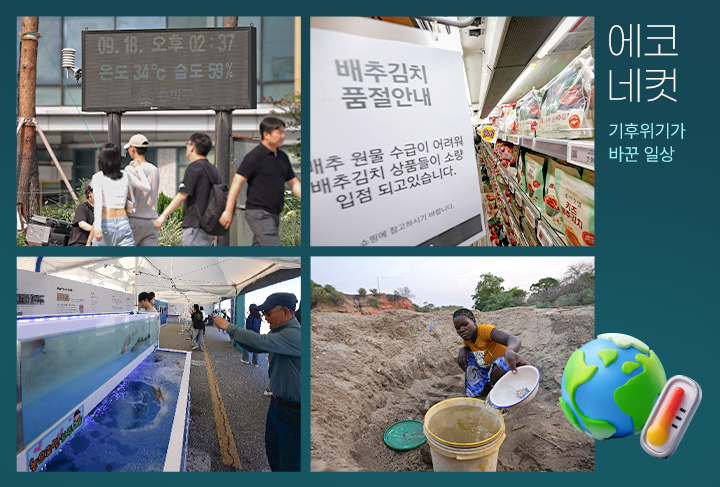The boundaries of Korea’s four distinct seasons, which were thought to be an absolute and immutable truth, are becoming blurred, and instead of cabbage kimchi and national fish, cabbage kimchi and unfamiliar fish species are appearing on our tables. This is a new daily life that has been changed by the climate crisis. On the other side of the world, the situation is even more serious, with life and death issues so much that our complaints about the weather and food are meaningless. Let’s take a closer look at four photos that show our daily lives changed by the climate crisis.
.
Lost autumn… Heat wave, spring flowers and severe cold?
On September 18th, when the fall heat wave was rampant, citizens wearing light clothes walked in front of an electronic display board showing a temperature of 34 degrees. (Source: Yonhap News)
This year’s summer was particularly long. The ‘Cheoseo Magic’, which claims that the heat will subside once Cheoseo passes, did not work, and a ‘heat wave warning’ was issued throughout the Chuseok holiday, which did not create a proper holiday atmosphere. The heatwave that continued until the end of September abated in November, skipping fall. But even though it was particularly bad this year, the summer was already getting longer. Recently, the Korea Meteorological Administration compared the past (1912-1940) with the past 10 years and found that the number of summer days increased from an average of 98 days to 127 days. These are all effects of global warming.
Therefore, the maple trees, which would have been colored yellow and red everywhere in previous years, were green throughout October this year. Instead, azaleas, which were supposed to bloom only in April, burst into flower buds in October, adding color. Normally, they should go dormant in cooler weather, but as temperatures remained high, they thought spring had come and started ‘sudden flowering.’ In addition, winter has arrived early this year, with mid-winter cold expected from mid-November.
Accordingly, the Korea Meteorological Administration is said to have begun work on readjusting Korea’s seasonal periods. The plan is to abolish the existing three-month seasonal classification and establish new standards tailored to actual temperature and weather conditions. Now, the long summer and short fall may no longer be ‘abnormal climate’.
.
Cabbage becomes a ‘golden cabbage’ due to climate change… What about kimchi this year?
Last September, a notice was posted in the packaged kimchi section of a large supermarket in Seoul regarding the opening of small quantities of kimchi due to cabbage supply issues. (Source: Yonhap News)
As of the 29th of last month, the Korea Price Association examined the prices of 15 kimchi ingredients at traditional markets in 17 cities and provinces and found that the cost of kimchi for a family of four this year was 419,130 won, a 19.6% increase from a year ago. This is because the prices of vegetables such as cabbage and radish have soared. In early October, the price of a head of cabbage exceeded 9,000 won for the first time in history, and even though the situation has improved slightly, the price remains higher than previous years.
The reason why cabbage prices have risen like this is due to the increase in abnormal weather conditions such as heat waves and heavy rain during the planting season (July to September) when cabbage should be planted this fall. The number of heat wave days in the regular season this year was 27.2, which was more than twice the number of 13.1 days in the same period last year, and the maximum rainfall per day in September was 117.7 mm this year, more than double last year’s 53.4 mm. Therefore, it is said that this year’s cabbage cultivation area was only 5,003ha (ha, 1ha = 10,000㎡), the smallest since statistics were compiled in 1975.
As a result, packaged kimchi products were sold out in supermarkets for a while, and in restaurants, kimchi made with cabbage was served instead of cabbage kimchi. An unprecedented situation has occurred in the history of Korea without kimchi. Fortunately, prices are normalizing now as cabbages grown late and imported products are starting to appear on the market, and the news continues that the later you can make kimchi this year, the better. The climate crisis is even changing our kimchi culture.
.
‘Pollack festival without pollack’ Now pollack, yellowtail and mackerel instead of squid
At the Goseong Pollack Festival held this year, about 10 pollacks raised through artificial hatching were released to the public. (Source: Yonhap News)
Last October, the ‘Pollack Without Pollack Festival’ was held in Goseong-gun, Gangwon-do for three days starting on the 11th. Until the 1980s, Goseong-gun was the main producing area of pollack, with hundreds of pollack fishing boats sailing to the port. However, as sea temperatures rise due to global warming, pollack can no longer be found, and fishing has been completely banned from 2019. So, most of the pollack sold in Korea now is from Russia, but Goseong-gun still produces processed pollack products and holds festivals to keep its legacy alive.
According to the National Institute of Fisheries Science, the average water temperature in Korea’s coastal waters has risen by 1.44 degrees over 56 years, especially in the East Sea by 1.9 degrees. Accordingly, not only pollock but also squid living in the East Sea were unable to avoid the effects of rising water temperatures. The squid catch, which averaged 200,000 tons per year in the 2000s, barely exceeded 20,000 tons last year, recording the lowest catch ever.
Instead, the catch of warm-water fish species such as yellowtail and mackerel has been steadily increasing over the past 40 years. According to the National Statistical Office, 45,000 tons of mackerel were caught last year, 10 times more than 10 years ago, and yellowtail, which was mainly produced in Jeju, has now become the representative fish species of the East Coast. How will the types of fish on our dinner tables change in the next 10 or 20 years?
.
Aftermath of El Nino hitting Africa… worst famine ever
Amid the severe drought that has struck Zimbabwe, residents are pumping water from deep underground to obtain drinking water. (Source: Yonhap News)
Should we turn our attention outside our country? On the other side of the world, Africa is suffering from severe drought that has lasted for several months, including food shortages. This disaster was caused by the El Niño phenomenon that lasted until May this year. El Niño is a meteorological phenomenon in which the sea surface temperature in the East Pacific increases abnormally when the surface water in the tropical Pacific changes direction and heats up. The El Niño phenomenon, which has continued since last year, reached its peak this year, causing the global temperature to rise by 0.2 to 0.25 degrees Celsius for the second consecutive year. We broke the record.
The UN World Food Program reported that more than 27 million people in southern Africa are facing a critical crisis due to this drought, and 21 million children are facing the worst possible hunger situation, with them suffering from malnutrition. In fact, countries such as Zambia and Zimbabwe in southern Africa have already declared national disasters due to famine, and countries such as Lesotho, Namibia, and Malawi have requested humanitarian support from the international community. In particular, Zimbabwe decided to slaughter 200 wild elephants for the first time since 1988 to provide food. Namibia also procures food by hunting several species of wild animals.
What’s more serious is that such severe droughts may occur more frequently in the future due to climate change. If the Earth’s temperature continues to rise, abnormal climates such as the atmosphere rapidly absorbing moisture, causing heavy rain, and then droughts may become more frequent. According to the World Meteorological Organization, 3.6 billion people around the world already do not have proper access to water for at least one month a year, and this population is expected to increase to 5 billion by 2050.
SK Eco Plant is building a business value chain to overcome the climate crisis that affects every aspect of our daily lives. Creating a sustainable tomorrow through ‘clean energy solutions’ based on renewable energy such as wind power and fuel cells, ‘environmental business’ based on waste battery recycling and AI, and ‘semiconductor comprehensive services’ that combine the circular economy. I’m on my way out. We hope that with the combined efforts of SK Eco Plant and all of us, our daily lives in the coming future will more closely resemble those of the past.


